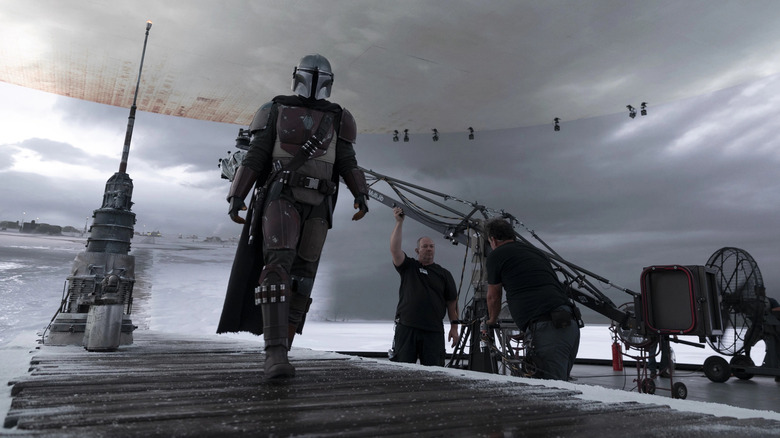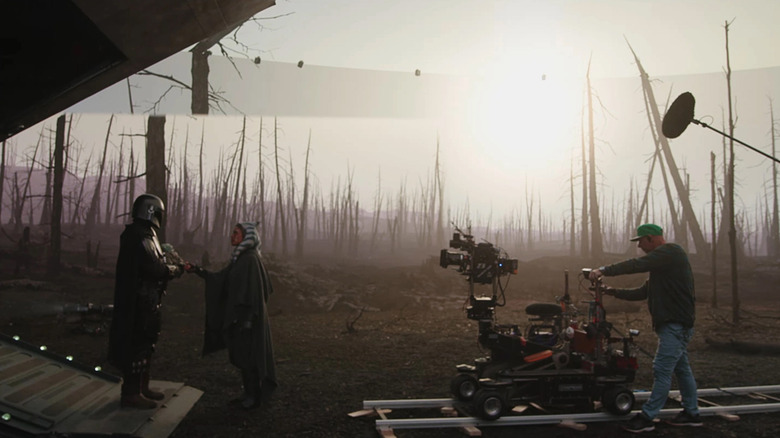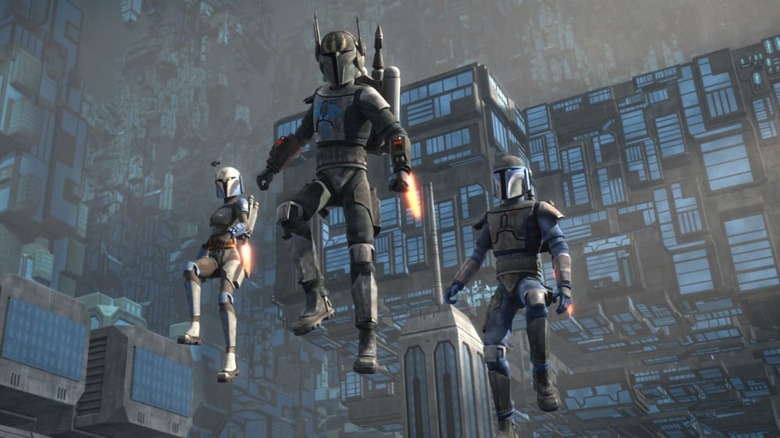The Mandalorian's StageCraft Technology Still Can't Perfectly Replicate Certain Environments
After the first two seasons of "The Mandalorian" and "The Book of Boba Fett," it should be clear that Jon Favreau, Dave Filoni and Robert Rodriguez are continuing to develop and work with new technologies to push the "Star Wars" galaxy to new heights. Ironically, the sci-fi fantasy aesthetic of "Star Wars" relies on practical effects, models, and a lived-in, antiquated look that has always been in lockstep with state-of-the-art advancements in digital cameras, CGI animation, and virtual production. That's where the digital set technology of Industrial, Light & Magic's volume (or StageCraft) comes into play.
In a brand spanking new Vanity Fair article on the eve of the season 3 premiere of "The Mandalorian," Favreau spoke about working on the cutting, bleeding edge of the still relatively new set technology that he readily admits is still evolving. Immersive virtual sets are the future, but there are still limitations that other filmmakers are going to inevitably run into, including "Ant-Man and the Wasp: Quantumania" director, Peyton Reed.
Since the debut of "The Mandalorian" in 2019, the StageCraft technology was largely kept under wraps to avoid spoiling the illusion of real landscapes and locations. From the look of it, the effect has been wildly successful. Introducing the new innovations of digital landscapes for the first time in "The Mandalorian" has shown that the world of "Star Wars" is very well-suited for the advantages of StageCraft, and conversely, its current limitations. The technology still can't replicate certain environments convincingly, but Favreau says it's only a matter of time.
Anakin doesn't like sand, but StageCraft does!
The technology helping to bring the most ambitious season of "The Mandalorian" to life continues to improve. It's been over two years since the rousing finale of season 2 of "The Mandalorian" premiered on Disney+. In that time, StageCraft has made new strides, but hard surfaces like the sands of Tatooine are still what look the best up on the massive LED panel screens. "If this was a jungle, it would be a lot harder," Favreau told Vanity Fair. ""Star Wars" lends itself because of hard surfaces — rocks, metal, droids. It makes it easier to make it look real faster. Organic stuff is harder."
It has another drawback, as well, Favreau revealed. "The exterior stuff with sunlight is the one thing you really can't do well here," he says. "So we still have outdoor sets that we go to with traditional blue screen ... What we've learned is when the light hits the walls, it reflects. The screen reflects." There's nothing like a glare on the television to ruin the suspension of disbelief.
StageCraft sounds like it's predominantly used to replicate outdoor environments in a location where it's helpful to have the light be completely controlled. The effect is used so well in "The Mandalorian" that it's almost impossible to tell what's a real location or not. Favreau confirming the technology's limitations outdoors makes perfect sense, and testing its limitations will only make it easier for StageCraft to recreate organic sunlight without dealing with the challenges of real world locations like weather and time. The technology is also influencing what kinds of stories Favreau writes, because he inevitably takes into account whether or not his ideas could work well inside the volume.
The planet Mandalore inside the volume
Favreau promises the technology "is going to get better and better and better," to the point where, hopefully, StageCraft is able to create moments of movie magic that rival some of the classic moments in "Star Wars." (Remember, that binary sunset Luke is watching in "Star Wars: Episode IV — A New Hope" is lit by the actual Tunisian sun.)
Season 3 of "The Mandalorian" has a lot of questions to address and will also be visiting the planet of Mandalore for the very first time in live-action. For fans of "The Clone Wars," seeing the Mandalorian culture and the continued history of the Darksaber should be especially exciting. The world of Mandalore, with its hard edges and Brutalist-inspired box architecture, should also play to the strengths of the current iteration of StageCraft.
The Siege of Mandalore — the Galactic Republic's devastating attack on the Outer Rim planet — will be shown on an epic scale in season 3 that will most likely heavily rely on huge doses of CGI. The moments down on the ground between Mando, Bo-Katan, and a host of other characters will, to the best of my knowledge, be set against the photo-real backdrops of the volume. The marriage of the two should work incredibly well together.
Favreau traditionally likes to keep things close to the chest. I would assume that's because he cherishes the mystery of moviemaking a little more than learning about the technology that made it happen. But he still loves being immersed in both. "We wanted people to see the show before we showed how we did it," he told Vanity Fair. "Now people are on board, so we don't mind showing how we do the magic trick."
"The Mandalorian" season 3 will begin streaming on Disney+ on March 1, 2023. This is the way.


